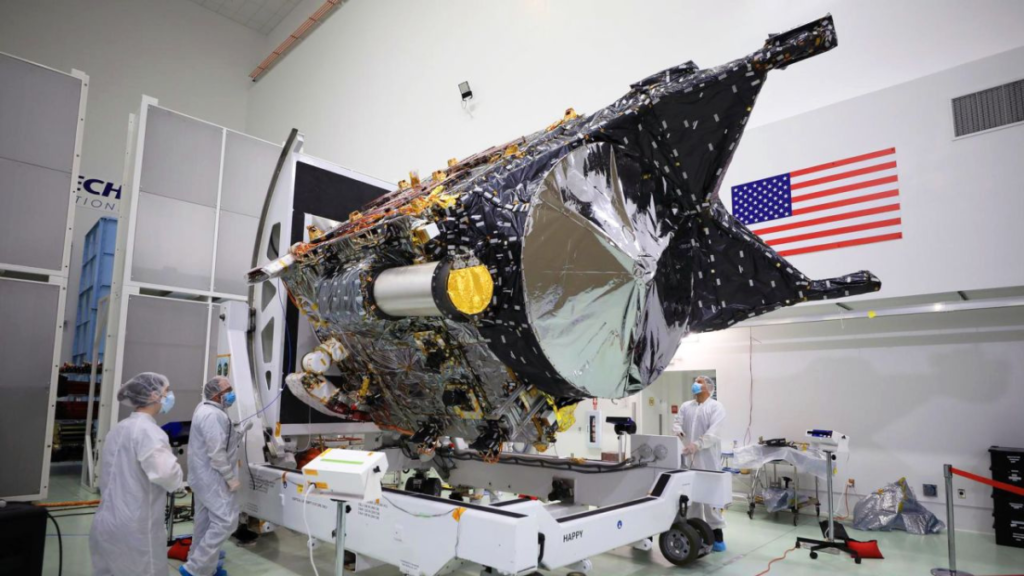In a groundbreaking achievement, NASA’s Psyche mission has achieved a historic milestone by successfully demonstrating laser communication from a distance of nearly 10 million miles. The Deep Space Optical Communications (DSOC) technology demonstration, First Light designed to be NASA’s most distant experiment in high-bandwidth laser communications, aims to challenge the limits of traditional radio wave systems. The invisible near-infrared laser employed by DSOC has the potential to transmit data at speeds 10 to 100 times faster than conventional communication systems used in previous missions. If successful, this experiment could lay the foundation for future communication technologies essential for human exploration, particularly in the context of potential Mars missions.
Journey to the Unknown: Psyche’s Bold Expedition
Psyche, named after the asteroid it is destined to unveil, embarks on an extraordinary journey covering 2.2 billion miles over six years to reach its celestial target. While the primary mission is to explore the metal asteroid located in the outer part of the main asteroid belt, the DSOC tech demo has been conducting its own mission during the initial two years of the voyage.
DSOC: Pushing the Boundaries of Communication
DSOC, designed to be NASA’s most distant experiment in high-bandwidth laser communications, seeks to challenge the limits of traditional radio wave systems. The invisible near-infrared laser employed by DSOC has the potential to transmit data at speeds 10 to 100 times faster than conventional communication systems used in previous missions. If successful, this experiment could lay the foundation for future communication technologies essential for human exploration, particularly in the context of potential Mars missions.
The Triumph of “First Light”
On November 14, DSOC achieved what engineers term as “first light” — successfully sending and receiving its first data. This historic moment involved beaming a laser, encoded with data, from a staggering distance of nearly 10 million miles. The data reached the Hale Telescope at the California Institute of Technology’s Palomar Observatory, marking a significant leap in laser communication capabilities.
The distance covered by DSOC during this feat was approximately 40 times farther than the moon’s distance from Earth. Trudy Kortes, director of technology demonstrations for the Space Technology Mission Directorate at NASA, stated, “Achieving first light is one of many critical DSOC milestones in the coming months, paving the way toward higher-data-rate communications capable of sending scientific information, high-definition imagery, and streaming video in support of humanity’s next giant leap: sending humans to Mars.”
Precision in the Cosmos: Overcoming Challenges
Achieving this milestone wasn’t without its challenges. The DSOC and Psyche operations teams had to work in tandem to fully incorporate ground assets and the flight transceiver. The successful test allowed the team to transmit, receive, and decode data, showcasing the potential for high-data-rate communications across vast distances.
This achievement builds on previous experiments in space communication, notably the Laser Communications Relay Demonstration launched by NASA in December 2021. While optical communications have been tested in low-Earth orbit and to the moon, DSOC’s accomplishment represents the first instance of laser communications across deep space, emphasizing the precision required over millions of miles.
Future Prospects: Revolutionizing Data Transmission
As DSOC moves forward, the team aims to refine the laser’s pointing accuracy. Once accomplished, DSOC will be prepared to send and receive data to and from the Hale Telescope as the spacecraft ventures farther from Earth. While DSOC won’t directly send scientific data collected by Psyche, it will use the laser to transmit test data encoded in the laser’s photons, showcasing the potential for a paradigm shift in how NASA communicates across deep space.
Dr. Jason Mitchell, director of the Advanced Communications and Navigation Technologies Division within NASA’s Space Communications and Navigation program, highlighted the significance of optical communication, stating, “Optical communication is a boon for scientists and researchers who always want more from their space missions, and will enable human exploration of deep space. More data means more discoveries.”
Challenges on the Cosmic Horizon
While DSOC’s successful “first light” is a major leap forward, challenges persist. The team is closely monitoring the time it takes for laser messages to traverse space. During the initial test, it took only 50 seconds for the laser to travel from Psyche to Earth. However, at the farthest distance between the spacecraft and Earth, this time is expected to increase to 20 minutes one way. Managing communication delays becomes crucial as the spacecraft continues its journey, and Earth’s rotation introduces additional complexities.
As Psyche prepares for its primary mission, the DSOC team continues to push the boundaries of communication technology. The mission, scheduled to arrive at the metal asteroid in July 2029, could unlock secrets about the early solar system, potentially revealing whether the asteroid is the exposed core of a planetary building block.
Conclusion
The success of DSOC’s “first light” represents a significant leap in communication technology, opening new possibilities for future deep-space exploration. As Psyche ventures into the unknown, the innovative use of laser communication technology may well become a cornerstone for humanity’s exploration of the cosmos.







